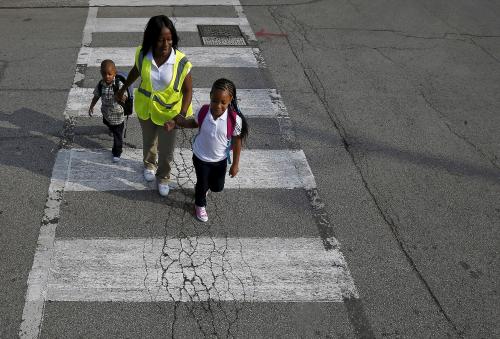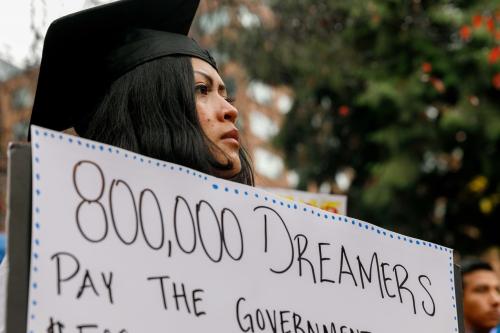Given the increasing polarization of the political debates about immigration, which has occurred in the context of persistent and growing socio–economic inequality in the United States, it is important to understand the possible influences of immigrants on U.S. schools. Immigrants and their children are one of the fastest-growing demographic groups—comprising 26% of the U.S. population in 2015.
Despite the claims by elected officials that immigrants consume a large share of social benefits, little is known about how immigrants affect schools and students who were born in the U.S. to U.S.-born parents (whom we refer to as third-plus generation students). Theoretically, an influx of immigrants might affect third-plus generation students via two channels: increased pressure on the educational system to accommodate a larger population of students with diverse needs (overcrowding, competition for resources, etc.); and peer effects on education outcomes.
The limited evidence about the effects of immigrant students on educational outcomes in receiving countries suggests that these effects vary by country, race, and grade level. In the U.S., having more immigrant peers appears to increase U.S.-born students’ chances of high school completion. Low-skilled immigration, in particular, is strongly associated with more years of schooling and improved academic performance by third-plus generation students. On the other hand, a rise in the number of immigrant students might increase segregation through the flight of third-plus generation students from schools with large shares of immigrant students.
Who are today’s immigrant students and their parents?
Immigrants and their descendants have been the driving force of population growth in the U.S. since the passage of the Immigration and Nationality Act in 1965. The law altered the nature of immigration to the United States by expanding the number of immigrants and their countries of origin. While most immigrants of previous generations were European and Canadian, most immigrants arriving after 1965 were Hispanic or Asian. Between 1965 and 2015, the immigrant population increased from approximately 5% to 14% of the U.S. population. Whereas most recent arrivals were Hispanic in 2000, this pattern has changed in the last decade, with 41% of the new arrivals being Asian and 39% Hispanic.
The change in U.S. immigration law also altered the socio-economic profile of immigrants, in particular Asian immigrants, by privileging those with high education levels and skills. Since 2000, newly arrived immigrants have been more likely to have finished college and have advanced degrees compared to U.S.-born adults. Recent arrivals are also more skilled compared to previous generations of immigrants, with 28% holding managerial and professional jobs. Overall, the personal earnings and median income of immigrant households have grown over time but remain slightly lower than their U.S.-born counterparts (though not for all immigrant groups).
The connection between immigrant students and educational resources
To examine how the presence of immigrants in the classroom is associated with student resources, we explore results from the Programme for International Student Assessment (PISA), an assessment administered to student samples in OECD countries every three years.
PISA data in Figure 1 indicate that the share of U.S. 15-year-old students with immigrant backgrounds increased from 18% in 2000 to 32% in 2015. These figures are consistent with the 2015 estimates from the United States Census Bureau data that show almost one out of four public school students in the U.S. came from a household with at least one immigrant parent. This trend coincided with a dramatic shift in school demographics over the same period: The share of Hispanic students among 15-year-olds increased twofold, from 15% to 30%. This growth was primarily due to the increase in the share of second-generation students–students born in the U.S. to parents with immigrant backgrounds. Correspondingly, the number and share of students who speak a language other than English at home has grown. Currently, one out of 10 K-12 public school students is considered limited English proficient (LEP), and about 70% were born in the U.S. and are U.S. citizens.
State legislatures require public schools to attend to the language needs of English language learners, which could strain school resources. We look at poverty levels and class sizes as indicators of student and school resources. As shown in Figure 2, poverty levels and class sizes increased from 2000 to 2015, but the growth in each measure was less pronounced than the increase in the share of students from immigrant families.
What are the effects on educational outcomes?
While an increasing share of LEP students creates additional challenges for schools, there is no evidence of negative effects on third-plus generation students’ educational outcomes. o the contrary, education programs for English language learners have positive effects on their non-LEP peers, and reclassifying LEP students as fully proficient increases their composite ACT scores and probability of enrolling in a postsecondary institution.
To explore further whether immigrants harm the educational outcomes of U.S. students, we examined PISA scores. If the claims of harm were true, we might expect to see lower academic achievement among third-plus generation students in schools with immigrant peers compared to schools attended exclusively by third-plus generation students.
We identified schools attended exclusively by third-plus generation students (which we called “isolated schools”) and compared the achievement of students in those schools to the achievement of third-plus generation students who were exposed to peers from immigrant families. We found that, on average, third-plus generation students in isolated schools had lower test scores than their third-generation peers in schools that served immigrant students, despite isolated schools having more teaching resources and lower levels of poverty. This finding was consistent even when we accounted for students’ backgrounds (gender, race, parental education, family wealth) and the characteristics of their schools such as school location, school type (public or private school), school and class size, and school climate.
Still, isolation might not be beneficial, since students in isolated schools do not have an opportunity to interact with their higher-achieving immigrant peers. In addition to academic outcomes, there are well-documented benefits from exposure to a diverse set of peers, and public schools are one of the primary places where youth can potentially interact with a broad range of peers, including but not limited to immigrant students.
Our analysis also revealed that while the achievement of first-generation students was lower compared to their third-generation peers, second-generation students slightly outperformed third-plus generation students. Once we controlled for race, gender, socio-economic status, and school contextual factors, the achievement gap between first-generation students and their second- and third-generation peers disappeared.
Taken together, our findings suggest that what is often perceived as an immigrant—native-born achievement gap is more likely to be a gender, racial, socio-economic, and resource gap. Likewise, there is no direct evidence that the increased share of immigrant students in the U.S. has negatively affected the educational outcomes of third-plus generation students, either through peer effects or resource channels.
The Brookings Institution is committed to quality, independence, and impact.
We are supported by a diverse array of funders. In line with our values and policies, each Brookings publication represents the sole views of its author(s).









Commentary
Are immigrant students disproportionately consuming educational resources?
October 3, 2019